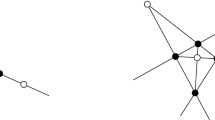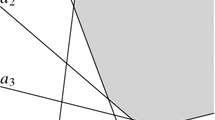Abstract
SupposeS is a planar space withv>4 points and letq be the positive real number such thatv=q 3+q2+q+1. Assuming a weak non-degeneracy condition, we shall show thatS has at least (q2+1)(q2+q+1) lines with equality iffq is a prime power andS=PG(3,q).
Similar content being viewed by others
References
N. G. de Bruijn, andP. Erdős: On a combinatorial problem,Indag. Math. 10 (1948), 421–423.
T. A. Dowling, andM. Wilson: The slimmest geometric lattices,Trans. Am. Math. Soc. 196 (1974), 203–215.
C. Greene: A rank inequality for finite geometric lattices,J. Comb. Th. 9 (1970), 357–364.
H. Hanani: On the number of straight lines determined byn points,Riveon Lematematika 5 (1951), 10–11.
R. G. Stanton, andJ. G. Kalbfleisch: The λ-μ problem: λ=1 and μ=3, in:Proc. Second Chapel Hill Conf. on Combinatorics, Chapel Hill, 451–462, 1972.




